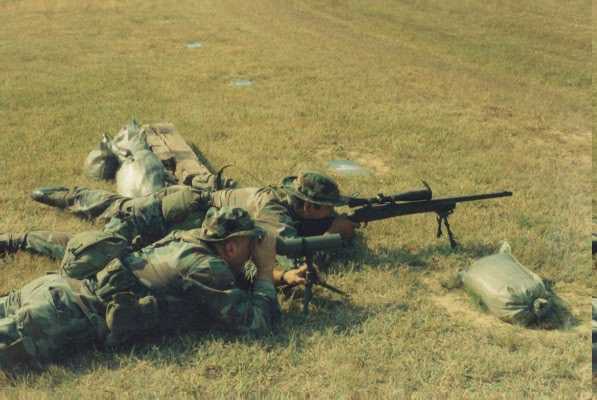Sniper/Spotter Relationship
BY SFC PETE CARPENTIER JR
NCOIC
SART SECTION

SFC P.Carpentier jr and SSG E.Becka TXNG at the 96 WPW National Championship
In this article I will talk about the sniper/spotter relationship, how they work as a team, how to train a spotter and how important his job is.
A sniper and spotter are a team. They will operate as a team. The sniper world is dominated by the perception not of one lone man but rather of a highly-skilled team of two men who act as one. With the exception of a few rare instances snipers operate in a team of two. As SSG Ed Becka of the Sarts would say " the sniper rifle is a crew served weapon". Usually the Spotter is the senior member of the team. Because the spotter has a very important job, he is usually the most experienced.
The spotter's job is very important. He will call the wind, help with the range estimate (two heads are better then one), will look for trace (where did that one go. AAH I didn't see that one) and if the sniper misses, he will be able to call the corrections and get the sniper on target. Also as SSG Becka would say " The sniper is the gas pedal and the spotter is the steering wheel". This means that a good spotter will locate the target, talk the shooter on to the target and help him obtain a hit on the target. Also this is very critically when making long range shots.
How to find a spotter and train one is not very hard. It takes practice. In sniper matches it is important to have a good spotter. Events like the snaps,movers, and unknown distance it helps to have a good spotter. I have been to matches where the sniper did not have a good spotter and the spotter would usually end up beating the sniper in the individual matches. A lot of times the spotter did not even know he won because he had a good spotter. At the AG Matches or Wilson, the teams are usually just put together before the match. And let me tell you that match day is not the time to find out you do not have a good spotter. Teams have lost because they did not have good spotters. And also teams that do end up on top are because they have worked together as a team. As I said before the spotter must be able to read the wind and be able to see trace. On matches like the moving target, the spotter must be able to see if the sniper has too much of a lead or not enough lead. Also communicate is very important. A sniper team must have good dialog. The most important part of the dialog is that both team members understand each other. This is very important before the sniper fires a shot. Here is an example of what to use. The spotter calls out the target to the sniper. The sniper finds the target and identifies it. The sniper calls out the range and asks the spotter for a wind call. The spotter checks the range and gives the sniper the wind call. The sniper says READY, this give the spotter the heads up to be looking though his spotting scope at the target. When the spotter is ready he will say SEND IT. As soon as the sniper fires he is looking for the trace to the target and if he misses, the spotter should be ready to give a correction. If the sniper does hit the target the spotter should also tell the sniper where he hit on the target.
How to train a spotter. The most important thing when training a spotter is his position. The spotter needs to be to the rear of the sniper and right next to him. I have seen spotters right next to the sniper on either side. In this position you might not be able to see the trace. The idea of being behind him and close is to be able to see the trace of the bullet. Also help the spotter with calling trace. One thing that I find helpfully is just get behind someone that is shooting and watch their trace. Also if you are firing on targets that are pulled and marked like they would be on a KD range, ask the spotter where that hit on the target before it comes up. Then when it does come up look to see if his call was close. Then there is wind calling. This also takes practice. Have the spotter look thought the scope and tell him to look down range at the grass and trees. Have him tell you which way the wind is blowing and then you check and see if he is calling it right. Also you should train the spotter on how to fill out a logbook. Also practice with range estimate.
I can not say it enough, the spotter's job is important. In training is the time to find out if you have a good spotter, instead of on a mission.
Articles
